Jaymes Dudding and his high school
students from Jemez Pueblo, NM on a trip
to India in 2008
Location |
Time | Date | ||
|
Depart Albuquerque |
9:30 AM |
Wednesday March 26 |
||
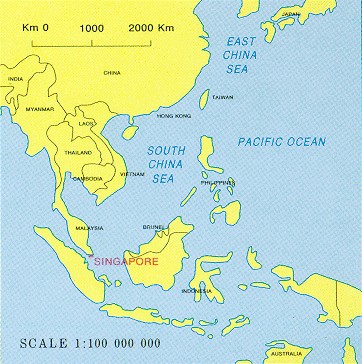 |
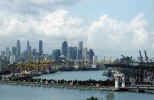 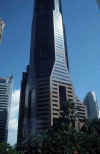 |
|||
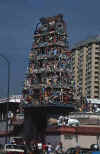
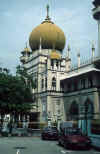
The Republic of Singapore is a city-state in Southeast Asia, situated on
the southern tip of the Malay Peninsula, south of the Malaysian state of
Johor and north of the Indonesian Riau Islands. The name Singapore was
derived from Malay word singa (lion). |
Thursday March 27 |
|||
Arrive Singapore -City Tour -River Boat Ride -Cable Car Ride To Mt. Faber -Merlion – Singapore icon -Singapore Museum *journaling *math conversion rates *Singapore history *work on essential question cable car ride to Mt. Faber 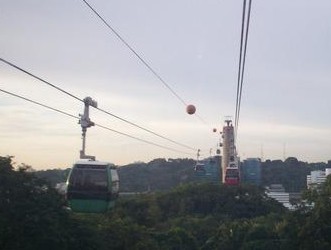
|
Early morning |
Thursday March 27 |
||
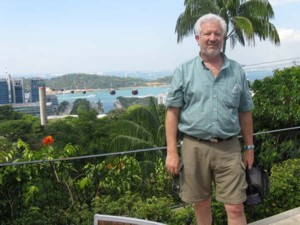
It's 2:10 am Friday, March 28. We arrived after a loooong flight that started on Wednesday in Albuquerque. Everything is closed in the city so we have 3 hours to kill before taking a tour of Singapore. Then we board again and head for Kolkata. Everything went fine so far. They stuffed us on the airplane, but I'M HUNGRY AGAIN. |
Thursday March 27 |
|||
Depart Singapore |
Early evening |
Friday March 28 |
||
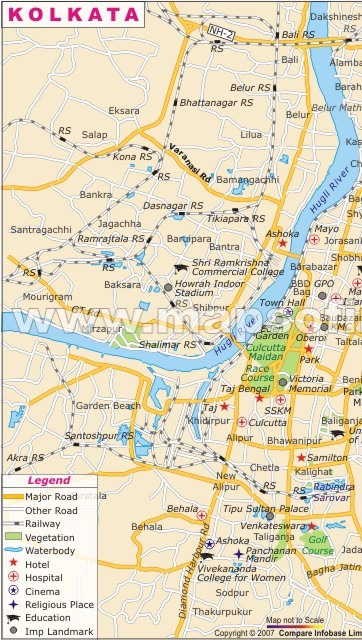
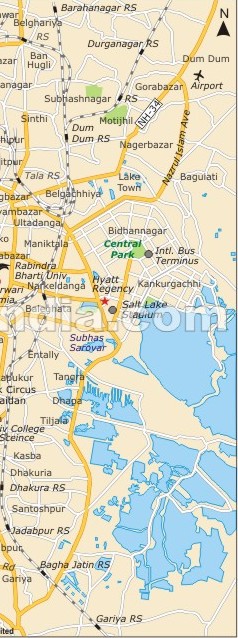
|
||||
Arrive Kolkata, India -Mother Theresa Orphanage -Queen Victoria Memorial -US Consulate -Theater excursion -Nagaland tribal emporium -Cricket instruction and game *journaling *study of indigenous tribes *math conversion rates *Spanish/Hindu vocabulary *green revolution 1967-1978 *Indian independence movement *work on essential question |
Late evening10:35 PM |
Friday March 28 |
||
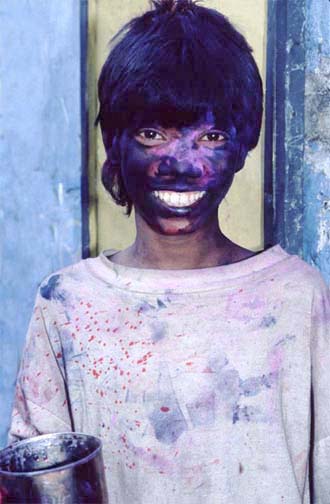 The
Lonely Planet guidebook to India is essential for any visitor to India.
Be sure to get an Indian visa before you go; you can't get one when you
arrive. Talk to a doctor or your local health department about
immunizations; none is required but it's wise to take precautions
against typhoid, tetanus, hepatitis, etc. Drink only bottled water and
avoid uncooked food. The
Lonely Planet guidebook to India is essential for any visitor to India.
Be sure to get an Indian visa before you go; you can't get one when you
arrive. Talk to a doctor or your local health department about
immunizations; none is required but it's wise to take precautions
against typhoid, tetanus, hepatitis, etc. Drink only bottled water and
avoid uncooked food.
Bring medicines to treat diarrhea and upset stomach. A combination lock is useful for securing your things. Calcutta is reasonably safe. You can use traveler's checks and credit cards. Both Citibank and American Express have offices in Calcutta. Although Calcutta is known for its poverty, it's a compelling city, a city with a soul, and a visit there can be one of the richest experiences on Earth. Your first impressions might be overwhelming; expect a bit of a shock.
The.Bengalis.are very fond of their capital city. For them and, indeed, for visitors from other countries, it's the cultural center of India. College Street has hundreds of bookshops, and there's a large university. India's most fascinating museums, such as the Indian Museum and Marble Palace, are in Calcutta. There are more publishers in Calcutta than in all the rest of India. Many poets and artists live there, and religious and cultural festivals enliven the city throughout the year. 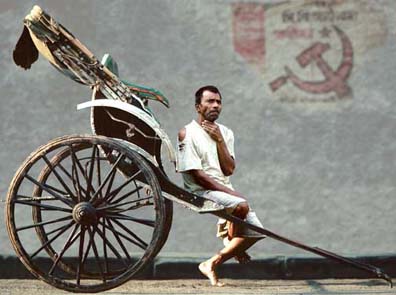
We made it to Kolkata last night. Kolkata is like Mexico on steroids. We had a wild cab ride from the airport to the heart of the city. Our rooms are air conditioned which is great. It is hot and humid here. People live on the street by the thousands. We saw them sleeping on the sidewalks everywhere. The students have been great. No problems and they look out for each other. Today we go to the India Museum and the market. We are careful about the food. We trust the people at our hotel. They know Kevin and Eleni our leaders from last trip. They treat him and therefore us, like old friends. Hugs, etc. Singapore was amazing and so affluent even compared to USA. Money money money. We took cable car ride, swam in the ocean, went to Hooters for supper. |
Friday March 28 |
|||
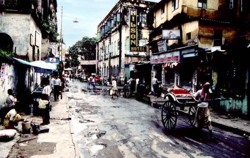 Day
two in Kolkata. Well, we went to early mass at Mother Theresa
Orphanage. Later, we took another wild ride in a taxi to the
Shrine of Kali Goddess of Death. A very wild scene ensued.
We got red dots on our foreheads after walking barefoot thorough
slop. Saw where they slaughter the goats every day. Visited
the Queen Victoria Museum. She had way too much money.
Tonight we saw a Tibetan Buddhist Sand Mandela be destroyed and Tibetan
dances. Tomorrow we learn to play cricket and take train to Puri. Day
two in Kolkata. Well, we went to early mass at Mother Theresa
Orphanage. Later, we took another wild ride in a taxi to the
Shrine of Kali Goddess of Death. A very wild scene ensued.
We got red dots on our foreheads after walking barefoot thorough
slop. Saw where they slaughter the goats every day. Visited
the Queen Victoria Museum. She had way too much money.
Tonight we saw a Tibetan Buddhist Sand Mandela be destroyed and Tibetan
dances. Tomorrow we learn to play cricket and take train to Puri. |
Sunday March 30 |
|||
Depart Kolkata by train for Puri |
Late evening |
Monday March 31 |
||
Arrive in Puri -Breakfast with Mary Ellen -Sustainability tour of MEG -Jaganut Temple -Orissa beach -Photography/Art lesson -student teaching (song and math) -pop-Hindi dancing -Mural painting -Leprosy Village -Konark Sun Temple -Raghurajpur Art Colony *journaling *sustainability research *sharing of tribal dances *work on essential question |
Early morning |
Tuesday April 1 |
||
MARY ELLEN GERBER FOUNDATION |
||||
|
||||
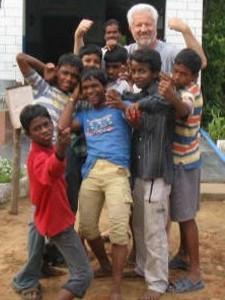 We are in Puri India on the coast and it is hot and humid. We are
staying now at the Mary Ellen Gerber Orphanage for abandoned
children. There are about 100 kids here from 1 year old to
16. The are so curious and very cute. Also smart.
Today we went to the beach for a swim and fun. The beaches are
pristine and the waves are big. Yesterday we went to the Temple of
the Sun or Carnark Temple. Amazing. It is covered with
relief sculptures of Karma Sutra sex positions of all kinds. The
kids enjoyed that immensely. Also, yesterday we went to a art
village where everyone in the village does some kind of art
We are in Puri India on the coast and it is hot and humid. We are
staying now at the Mary Ellen Gerber Orphanage for abandoned
children. There are about 100 kids here from 1 year old to
16. The are so curious and very cute. Also smart.
Today we went to the beach for a swim and fun. The beaches are
pristine and the waves are big. Yesterday we went to the Temple of
the Sun or Carnark Temple. Amazing. It is covered with
relief sculptures of Karma Sutra sex positions of all kinds. The
kids enjoyed that immensely. Also, yesterday we went to a art
village where everyone in the village does some kind of art
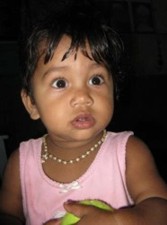 or craft. For example they do very intricate "engraving" o palm
leaves and then stitch them together to make a wall hanging.
Subjects vary but mostly gods and goddesses and animals. Cool.
This town is only 500,000 people and considered a resort town. I
took a camel ride today... very bumpy and hard on the
huevos! We have a few more days here and then another 10 hour
overnight train ride back to Kalkuta then on to Darjeeling for a few
days. Too bad I hate tea. Everyone is well except for
mosquito bites and tired of eating rice and vegetables everyday at the
orphanage..
or craft. For example they do very intricate "engraving" o palm
leaves and then stitch them together to make a wall hanging.
Subjects vary but mostly gods and goddesses and animals. Cool.
This town is only 500,000 people and considered a resort town. I
took a camel ride today... very bumpy and hard on the
huevos! We have a few more days here and then another 10 hour
overnight train ride back to Kalkuta then on to Darjeeling for a few
days. Too bad I hate tea. Everyone is well except for
mosquito bites and tired of eating rice and vegetables everyday at the
orphanage.. |
Thursday April 3 |
|||
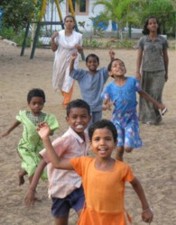 Mary Ellen Gerber is quite a lady. She holds several US patents for a
special cabinet hinge that she invented which is now in almost every
American kitchen. She made millions on it and after the Hurricane here
she sold everything and built three different orphanages in India. She
also supports a leper colony.
Mary Ellen Gerber is quite a lady. She holds several US patents for a
special cabinet hinge that she invented which is now in almost every
American kitchen. She made millions on it and after the Hurricane here
she sold everything and built three different orphanages in India. She
also supports a leper colony.
Since our beach adventure we spent two days at
the orphanage working on various projects. I worked on getting the
computers downloaded with the software for the little digital $10.
cameras that we brought for the kids. Finally got that working and
printed out some of the photos the kids took. Another group of students
worked on assembling a new clothes line near one of the dorms.
|
Sunday April 6 |
|||
Depart Puri Orphanage |
Late evening |
Monday April 7 |
||
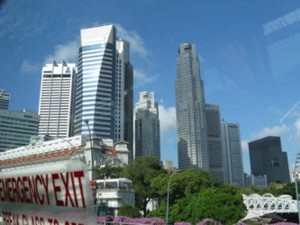 We are back in Kolkata temporarily after an overnight train ride from
Puri. We leave again tonight for another overnight on our way to
Darjeeling in the cool mountains at the foot of the Himalayas. After a
week of eating rice and boiled vegetables the students are pigging out
on American junk food. The Mary Ellen Gerber Orphanage
experience was incredible. The kids steal your heart. I'm going to
sponsor one of them. It's only $30. a month or so. Baby Valentine was
abandoned because she was the 5th girl in the family and the father
didn't want her. She was born on Valentine day. More adventures lay
ahead.
We are back in Kolkata temporarily after an overnight train ride from
Puri. We leave again tonight for another overnight on our way to
Darjeeling in the cool mountains at the foot of the Himalayas. After a
week of eating rice and boiled vegetables the students are pigging out
on American junk food. The Mary Ellen Gerber Orphanage
experience was incredible. The kids steal your heart. I'm going to
sponsor one of them. It's only $30. a month or so. Baby Valentine was
abandoned because she was the 5th girl in the family and the father
didn't want her. She was born on Valentine day. More adventures lay
ahead. |
Tuesday April 8 |
|||
Arrive Kolkata -Science village tour *Sustainability Research |
Early morning |
Tuesday April 8 |
||
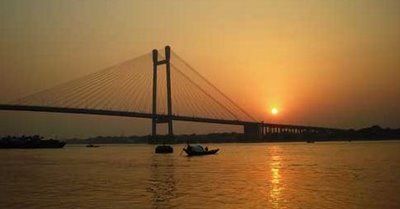 Kolkata
(formerly Calcutta) - the city of joy, city of Rabindranath, city of
Satyajit Ray, city of intellectuals, city of football, city of
procession, city of political movements, city of Bundhs (strike) , city
of arts and culture (cultural capital of India), city of festivals and
at last but not the least it is also known as city of best sweets and
cuisine. It is located on Calcutta's Eastern Metropolitan Bypass. This
21st century marvel of science, communication and environment is the
first and only institution of its kind in India. The pioneering effort
of NCSM, in setting up open air Science Parks has now added a new
dimension to science teaching through a process of discovery
in the outdoor setting. Set amidst trees and lawns, here one finds
science out of doors and alive. Kolkata
(formerly Calcutta) - the city of joy, city of Rabindranath, city of
Satyajit Ray, city of intellectuals, city of football, city of
procession, city of political movements, city of Bundhs (strike) , city
of arts and culture (cultural capital of India), city of festivals and
at last but not the least it is also known as city of best sweets and
cuisine. It is located on Calcutta's Eastern Metropolitan Bypass. This
21st century marvel of science, communication and environment is the
first and only institution of its kind in India. The pioneering effort
of NCSM, in setting up open air Science Parks has now added a new
dimension to science teaching through a process of discovery
in the outdoor setting. Set amidst trees and lawns, here one finds
science out of doors and alive. |
||||
Depart Kolkata |
Late evening |
Tuesday, |
||
Arrive Siliguri -take 3 hour jeep ride |
Early morning |
Wednesday April 9 |
||

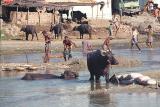 Silguri is the main commercial city of North Bengal and its importance comes
from its strategic location near international and state borders. It is
situated on the banks of the river Mahananda. Spread around the
foothills of the eastern Himalayas, the town is an important
transportation, trading and educational center.
Silguri is the main commercial city of North Bengal and its importance comes
from its strategic location near international and state borders. It is
situated on the banks of the river Mahananda. Spread around the
foothills of the eastern Himalayas, the town is an important
transportation, trading and educational center. |
||||
Arrive Darjeeling -hike to Andy's Guesthouse -breakfast at Glenaries -Himalayan Mountaineering Inst. -Mountaineering museum and film -Tibetan Refugee Camp -Tiger Hill -Ghoom Monastery, prayer wheels and Golden Buddha -Darjeeling tea estates *Himalayan geology and sunrise over Kanchenjunga *History of Tibetan Refugee Camp, and weaving presentation *Kerala discussion and quiz *journalingg *work on essential question |
Late morning |
Wednesday April 9 |
||
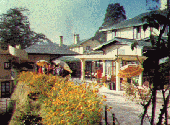 We are in Darjeeling for one more day after this. We still haven't
glimpsed the Himalayas because of mist. We are still hopeful. We were
almost caught in a demonstration in Siliguri which
turned violent the day we arrived. The local people here are of
oriental linage. They look like Chinese instead of the typical Indian
features. Actually, they resemble our own Jemez students very much. They
want their own state separate from
We are in Darjeeling for one more day after this. We still haven't
glimpsed the Himalayas because of mist. We are still hopeful. We were
almost caught in a demonstration in Siliguri which
turned violent the day we arrived. The local people here are of
oriental linage. They look like Chinese instead of the typical Indian
features. Actually, they resemble our own Jemez students very much. They
want their own state separate from
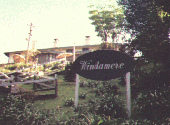 India
because of miss-treatment by India in terms of jobs, and other
discrimination. Yesterday the whole city of Darjeeling was shut down on
strike. We had to rely on friends at a restaurant to bring us food and
water. Everything is back to normal today. It reminded me of the 60's
back home. It is beautiful here. Mostly Buddhist instead of Hindu.
Today we went to the oldest Buddhist temple in Darjeeling. Also we India
because of miss-treatment by India in terms of jobs, and other
discrimination. Yesterday the whole city of Darjeeling was shut down on
strike. We had to rely on friends at a restaurant to bring us food and
water. Everything is back to normal today. It reminded me of the 60's
back home. It is beautiful here. Mostly Buddhist instead of Hindu.
Today we went to the oldest Buddhist temple in Darjeeling. Also we
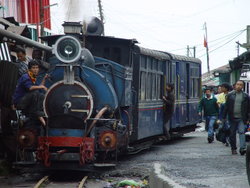 went
to the Himalayan Mountain Climbing Museum and the Darjeeling Zoo. There
are great bargains everywhere on all kinds of art and craft items.
Tomorrow we may try to get up real early and see the Himalayas at dawn.
We board the train in Siliguri tomorrow night and
head back to Kolkata and one day later head back to the the states. I
will part company with the group and fly to Manilla to see Anna and Shae
for 4 days. went
to the Himalayan Mountain Climbing Museum and the Darjeeling Zoo. There
are great bargains everywhere on all kinds of art and craft items.
Tomorrow we may try to get up real early and see the Himalayas at dawn.
We board the train in Siliguri tomorrow night and
head back to Kolkata and one day later head back to the the states. I
will part company with the group and fly to Manilla to see Anna and Shae
for 4 days. |
Friday April 11 |
|||
|
|
||||
Depart Darjeeling for Siliguri |
Early evening |
Saturday April 12 |
||
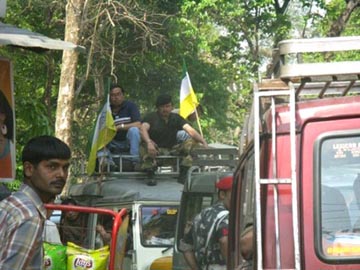
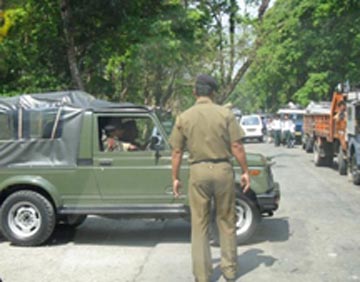 I might go back next year, maybe. At Siliguri we witnessed a confrontation which turned into a riot between Ghorka separatists and the Army/Police. They shut down Darjeeling for 24 hours in solidarity. We would have been stuck without food and water except for some friends that took care of us. Ahh, the Sixties! |
||||
Arrive Kolkata -market shopping -theater excursion *journaling *group discussion on “essential question” and presentations |
Early morning |
Sunday April 13 |
||
Depart Kolkata |
Early evening |
Monday April 14 11:50 PM |
||
| Singapore was amazing. I spent two days there. It is very modern and rich, rich. Singapore Airlines is the airline we took. Best in the world. Their stewardess are all just beautiful. They look like they have been cloned. Singapore did remind me of the book 1984 too much though. Don't even spit on the sidewalk, somebody is watching. | Arrive Manila | |||
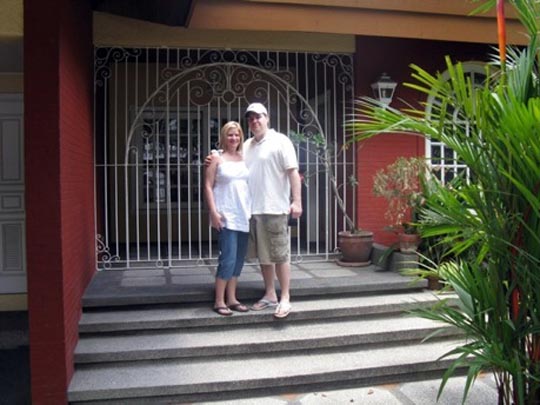 Manila was interesting. At least they have a 'middle' class. But because they
do, they have too many cars and motorcycles on the road. You can't go
anywhere that is not bumper to bumper. While I was there they passed 88
million on that tiny bunch of islands. Just like Mexico, we can thank
the Catholic Church. Anna and her husband Shae live like royalty. They
have a maid/housekeeper/cook that lives in a room off the kitchen; as
well as a driver that has a little room upstairs that he climbs an outdoor ladder to get to.
Manila was interesting. At least they have a 'middle' class. But because they
do, they have too many cars and motorcycles on the road. You can't go
anywhere that is not bumper to bumper. While I was there they passed 88
million on that tiny bunch of islands. Just like Mexico, we can thank
the Catholic Church. Anna and her husband Shae live like royalty. They
have a maid/housekeeper/cook that lives in a room off the kitchen; as
well as a driver that has a little room upstairs that he climbs an outdoor ladder to get to. |
||||
Arrive Albuquerque |
Afternoon |
Tuesday April 15 |
||
| Now that I'm back for a week and a half, I'm starting to get my energy back. It was a real adventure into a third world country. The caste system is still in effect. I saw lots of lower caste women working as laborers carrying stacks of huge bricks stacked 6 - 8 high on top of their heads. Everything is done by hand: buildings, roads, everything. I saw only one front-end loader the entire trip. They sleep in the street or sidewalks everywhere. We stepped over them sometimes. | ||||
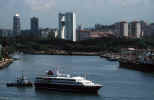
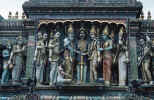 Singapore joined the Federation of Malaysia shortly afterwards. On
expulsion from Malaysia in 1965, Singapore was separated from its
traditional markets and faced economic degeneration. In resolution,
government-led rapid industrialization and
business-friendly policies stimulated some of the fastest economic
growth in the modern world.
Singapore joined the Federation of Malaysia shortly afterwards. On
expulsion from Malaysia in 1965, Singapore was separated from its
traditional markets and faced economic degeneration. In resolution,
government-led rapid industrialization and
business-friendly policies stimulated some of the fastest economic
growth in the modern world. 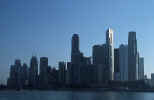
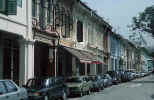 Singapore now has one of the highest gross
domestic product (GDP) per capita rates in the world; it is a major
financial, transport and medical hub. Crime is low,
and Transparency International consistently rates it as one of the
least corrupt countries in the world.
Singapore now has one of the highest gross
domestic product (GDP) per capita rates in the world; it is a major
financial, transport and medical hub. Crime is low,
and Transparency International consistently rates it as one of the
least corrupt countries in the world.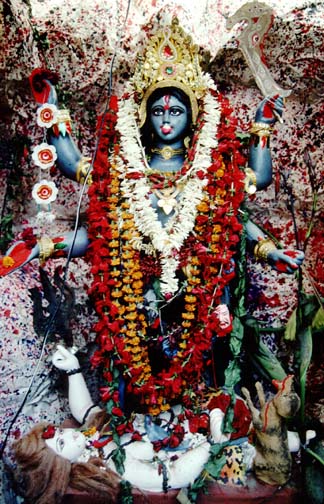 In many ways Calcutta seems familiar: the English street names, the
architecture, the English language. At the same time the context is so
foreign. The effect is very odd, sometimes even frightening to the
Western visitor. Bengali culture is magnificent. Bengali is spoken by
more people than is French or Japanese. Rabindranath Tagore won the
Nobel Prize for his epic verse Gitanjali in 1913; he wrote in Bengali.
You can read Tagore's works in English translation; Penguin Books has an
edition of selected poems. Satyajit Ray made his wonderful films in
Bengali; newly restored versions are available on videotape with English
subtitles. Try to find, for example, The World of Apu...
In many ways Calcutta seems familiar: the English street names, the
architecture, the English language. At the same time the context is so
foreign. The effect is very odd, sometimes even frightening to the
Western visitor. Bengali culture is magnificent. Bengali is spoken by
more people than is French or Japanese. Rabindranath Tagore won the
Nobel Prize for his epic verse Gitanjali in 1913; he wrote in Bengali.
You can read Tagore's works in English translation; Penguin Books has an
edition of selected poems. Satyajit Ray made his wonderful films in
Bengali; newly restored versions are available on videotape with English
subtitles. Try to find, for example, The World of Apu... 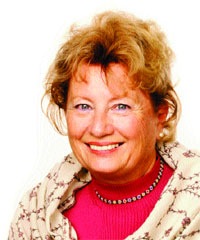 Mary-Ellen Gerber
Mary-Ellen Gerber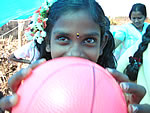 What better way to utilize one's strength, wisdom and experience than to
help those who will lead our future? Mary-Ellen Gerber takes this notion
much further - to India to be precise, where she has taken on the
welfare of hundreds of children orphaned by the 1999 cyclones in rural
North East India, and is helping them to build new lives. After selling
her successful business in Los Angeles, Mary-Ellen heard about the
Orissa
What better way to utilize one's strength, wisdom and experience than to
help those who will lead our future? Mary-Ellen Gerber takes this notion
much further - to India to be precise, where she has taken on the
welfare of hundreds of children orphaned by the 1999 cyclones in rural
North East India, and is helping them to build new lives. After selling
her successful business in Los Angeles, Mary-Ellen heard about the
Orissa 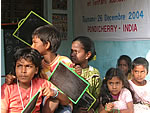 cyclone,
one of the worst in modern history, which killed more than 30,000 and
left over 3,000 children orphaned. Mary-Ellen flew to India to begin
feeding and fostering the huge numbers of children found in rags
wandering the streets, living on railway platforms or other horrendous
living conditions.
cyclone,
one of the worst in modern history, which killed more than 30,000 and
left over 3,000 children orphaned. Mary-Ellen flew to India to begin
feeding and fostering the huge numbers of children found in rags
wandering the streets, living on railway platforms or other horrendous
living conditions.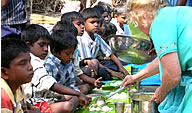 began building them a village. Today it houses 166 children, and there is a
second village in the works in the nearby county of Vishakhapatnam for
the orphans, as well as the region's children of leprosy victims.
began building them a village. Today it houses 166 children, and there is a
second village in the works in the nearby county of Vishakhapatnam for
the orphans, as well as the region's children of leprosy victims.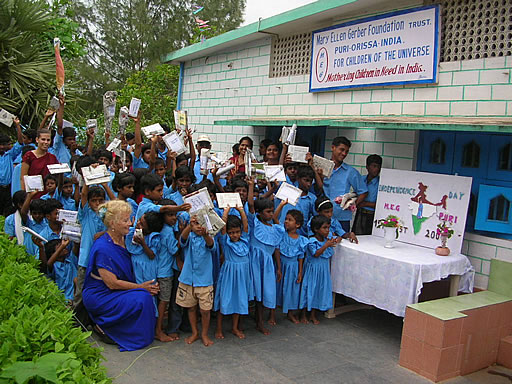
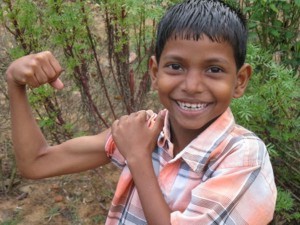 Last
night was bonfire night. The kids danced their hearts out to "Indie
Pop". Such energy! After that, the high school students from Jemez did a
traditional dance for the kids. They loved it. We have fun playing with
the kids. Usually there is a pick-up Crickit game every afternoon.
Last
night was bonfire night. The kids danced their hearts out to "Indie
Pop". Such energy! After that, the high school students from Jemez did a
traditional dance for the kids. They loved it. We have fun playing with
the kids. Usually there is a pick-up Crickit game every afternoon.
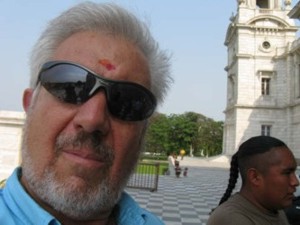
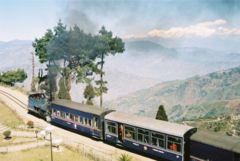 The Darjeeling Himalayan Railway, nicknamed the
"Toy Train", is a 2 ft (610 mm) gauge narrow-gauge railway from Siliguri
to Darjeeling in West Bengal, run by the Indian Railways. It was built
between 1879 and 1881 and is about 86 km long. The elevation level is
from about 100 m at Siliguri to about 2,200 m at Darjeeling. It is still
powered by a steam engine. A modern diesel engine is used for
Darjeeling’s mail. Since 1999 the train has been a World Heritage Site
as listed by UNESCO. In 2005, UNESCO added the Nilgiri Mountain Railway
as an extension to the original inscription.
The Darjeeling Himalayan Railway, nicknamed the
"Toy Train", is a 2 ft (610 mm) gauge narrow-gauge railway from Siliguri
to Darjeeling in West Bengal, run by the Indian Railways. It was built
between 1879 and 1881 and is about 86 km long. The elevation level is
from about 100 m at Siliguri to about 2,200 m at Darjeeling. It is still
powered by a steam engine. A modern diesel engine is used for
Darjeeling’s mail. Since 1999 the train has been a World Heritage Site
as listed by UNESCO. In 2005, UNESCO added the Nilgiri Mountain Railway
as an extension to the original inscription. 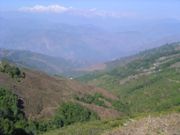 Originally just a cluster of villages that was administered intermittently by
Nepal and Sikkim, Darjeeling grew in prominence during the mid 19th
century when, because of its climate, the British first established a
hill station there after leasing it from the Chogyal of Sikkim and later
discovered that the area was particularly well suited for tea
plantations. In 1849, the British annexed the area and Darjeeling became
a part of British India. The Darjeeling
Originally just a cluster of villages that was administered intermittently by
Nepal and Sikkim, Darjeeling grew in prominence during the mid 19th
century when, because of its climate, the British first established a
hill station there after leasing it from the Chogyal of Sikkim and later
discovered that the area was particularly well suited for tea
plantations. In 1849, the British annexed the area and Darjeeling became
a part of British India. The Darjeeling
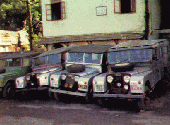 Himalayan Railway was opened in 1881 (it is now a UNESCO World Heritage Site) and
the town became the de-facto summer capital of India during the days
when the Raj was governed from Calcutta. Because it was a popular hill
station during the days of the Raj, a lovely Victorian town was built
among the Himalayan
foothills, the remnants of which are still visible around the
Chowrasta and Darjeeling remains a
Himalayan Railway was opened in 1881 (it is now a UNESCO World Heritage Site) and
the town became the de-facto summer capital of India during the days
when the Raj was governed from Calcutta. Because it was a popular hill
station during the days of the Raj, a lovely Victorian town was built
among the Himalayan
foothills, the remnants of which are still visible around the
Chowrasta and Darjeeling remains a
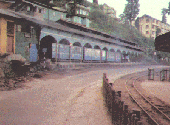 popular summer and fall resort for the natives of Kolkata today. For foreign
tourists, the main attractions are the cultural diversity (many Tibetan
refugees moved here after Tibet was annexed by China and they co-exist
with the descendants of the many Nepali and Bihari laborers brought to
work in the tea plantations), the beautiful views (including the
wonderful vista view of Kanchenjunga), a variety of trekking options,
and the
popular summer and fall resort for the natives of Kolkata today. For foreign
tourists, the main attractions are the cultural diversity (many Tibetan
refugees moved here after Tibet was annexed by China and they co-exist
with the descendants of the many Nepali and Bihari laborers brought to
work in the tea plantations), the beautiful views (including the
wonderful vista view of Kanchenjunga), a variety of trekking options,
and the 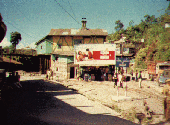 opportunity
to cool down after a stint in the plains. The town is also a jumping
off point for travelers heading to Sikkim. There has been intermittent
political action from Gorkha groups demanding an independent state
(Gorkhaland). However, in recent years, the agitation
has largely died down but do check local conditions before visiting
the hills around Darjeeling.
opportunity
to cool down after a stint in the plains. The town is also a jumping
off point for travelers heading to Sikkim. There has been intermittent
political action from Gorkha groups demanding an independent state
(Gorkhaland). However, in recent years, the agitation
has largely died down but do check local conditions before visiting
the hills around Darjeeling.